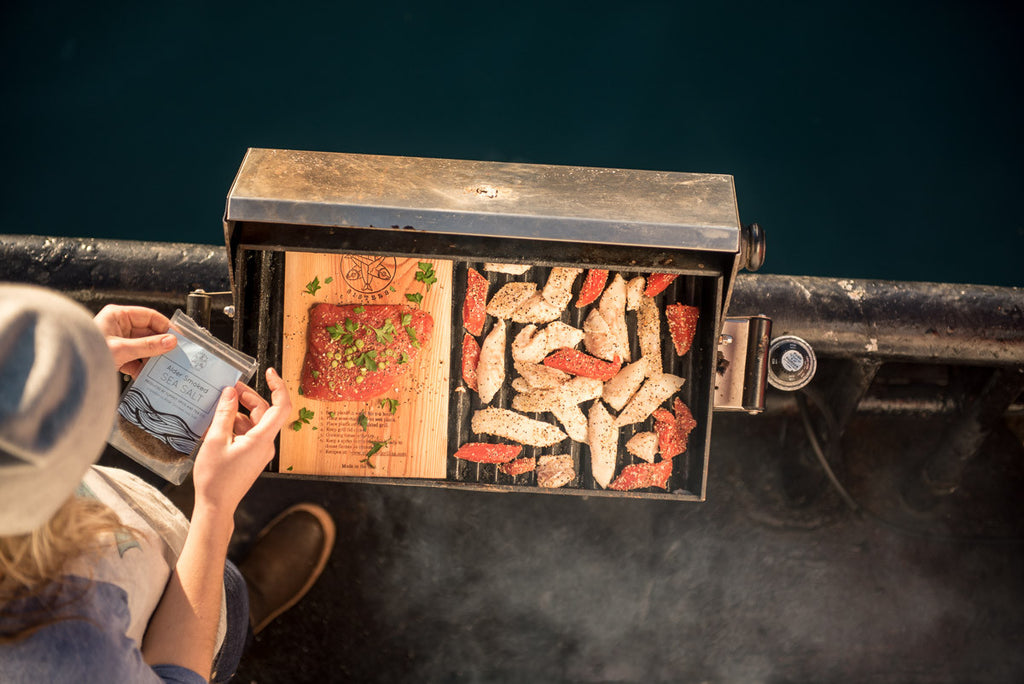Why Wild
Your Health
Eat wild Alaska seafood for a healthy heart, healthy bones and a powerful brain.
By purchasing a Salmon Sisters share you are making an investment in your health. Naturally rich in protein, vitamin D, and Omega-3 fatty acids, wild Alaska seafood is the start to a perfectly nutritious meal. The American Heart Association recommends eating at least two servings of fish per week! Find out more at the American Heart Association.
Few single foods bring so much nutritional wealth to the table as Alaska salmon. The fish provides high quality, easily digestible protein containing all the essential amino acids. Salmon contains generous amounts of vitamin D – a vitamin seldom found in food – and the B vitamins B6, B12, niacin and riboflavin. Salmon are a premier source of long-chain omega-3 fatty acids, unique polyunsaturated fatty acids with an array of health benefits. Omega-3s in salmon reduce the chance of dying from heart disease and improve both blood flow and the profile of different types of lipids in the blood. Omega-3s are important in brain structure and function, and in reducing inflammation.
“Conventional wisdom says that a healthy diet is one that is low in fat and – invariably –short on flavor. We beg to differ. And so do millions of connoisseurs of Alaska seafood the world over. You can study reams of nutritional research. Or, simply observe the extraordinary health and longevity of people in countries where seafood is a mainstay of the diet. Either way, Alaska seafood is as healthy as it is delicious.” (Source: Alaska Seafood Marketing Institute)
When we eat Wild Alaska Seafood, we feel better. Commercial fishing is a physically challenging job, and by eating seafood daily on the boat, we maintain strength and focus. Also, this rich source of Omega-3 fatty acids helps our bodies fight against premature aging, keeping our bodies and minds vibrant and youthful.
The flavor of Alaska salmon depends upon its fat content and the environment in which it matured. Alaska’s icy pure waters and the abundance of natural food give Alaska salmon unparalleled flavor.
Check out the Alaska Seafood Marketing Institute’s Alaska Seafood Nutrition Information chart to find nutritional values and calorie content of Wild Alaska Seafood, giving even more reasons to feel good about eating Wild Alaska Seafood! We are proud of our product!
Sustainable Fisheries
Sustainably harvested, Alaska's abundant, well-managed commercial salmon fisheries support a thriving commercial fishing and seafood processing industry. Anchored in strict conservation practices, delicious Alaska Seafood will be enjoyed for generations to come.
Sustainability allows fisheries to exist long-term in Alaska without compromising the surrounding ecosystem. Alaska’s fisheries are managed to minimize habitat damage and protection against overfishing. Our fishery is a well-managed, sustainable resource. Alaska’s fisherman realize the importance of fishing communities and are dedicate to sustainable fishing practices, thus preserving the abundant industry for generations to come.
The Salmon, Halibut, and Pacific Cod and Sablefish we catch are closely monitored through precautionary resource management by the National Marine Fisheries Service and the Alaskan Department of Fish & Game. Sustainability is part of the Alaska constitution and its successful management practices set the bar worldwide.
Find more by accessing Alaska Seafood Marketing Institute’s awesome Alaska Seafood Sustainability in Plain English explanation and other credible sources on Alaska’s sustainable fisheries such as Alaska Department of Fish & Game.
Alaska’s fisheries meet the criteria of United Nations Food and Agriculture Organization (FAO) code of Conduct for Responsible Fisheries, the most comprehensive and respect fisheries management guidelines in the world.
The Wild Difference
Wild Alaska seafood is a truly natural food source. The fish around the Aleutian Islands live as mother nature intended – there are no hatcheries or fish farms there. With responsible fishery management the fish are an ever-renewable resource. Some fishing seasons are more productive then others, and the independent fishermen must live with the risk of striking out. But we continue to go out, day after day, because we love what we do and we are proud of what we produce. The difference in quality between wild-caught and farm-raised seafood will speak for itself.
Farmed fish are mass-produced in an unnatural habitat, typically a large net-pen. They are fed concentrated fish meal and create a significant amount of waste and disease in the waters surrounding their pens. Often referred to as “aquaculture,” fish farming is a corporate-run, large scale industry. Aquaculture is focused on the quantity produced rather than the quality of the product, and this has allowed farmed fish to undercut the wild caught fish in the marketplace. This is not only affects the livelihood of the independent fishermen, but it also has a negative effect on the ecosystem of the ocean.
You can find more information on this discussion by visiting the Alaska Seafood Marketing Institute’s website. Learn more from Salmon: Wild vs. Farm diagram on “how wild & cultivated salmon impacts our health & the environment.” We at Salmon Sisters truly believe that wild Alaska seafood is good for you, good for the fishermen, and good for the planet.

